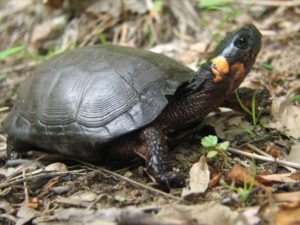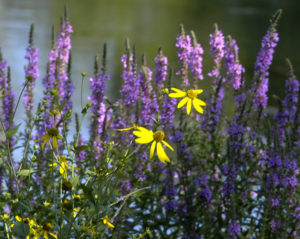A Brilliant Jewel in New Jersey’s Treasure Chest of Natural Wonders Revealed
Article by Joseph Mish, photos by Joseph Mish and Brian Zarate
A moment in the sun. The elusive and rare bog turtle, aka Muhlenberg turtle, is captured in this image by Brian Zarate.
The smallest and rarest turtle in NJ has emerged from the obscurity of its muddy bog to celebrity status as the bog turtle was recently named New Jersey’s state reptile.
The bog turtle was first scientifically cataloged by botanist Gotthilf Muhlenberg at the approach of the 19th century. In honor of the discoverer, this diminutive reptile was named Clemmys muhlenbergii. It was commonly known as the Muhlenberg turtle until the vagaries of taxonomic nuance christened it the bog turtle, one hundred and fifty-six years later.
The bog turtle averages a bit less than four inches in length. To visualize its size, write its scientific name on a piece of paper and that length will approximate the size of the turtle.
The blaze orange patch on the side of its head provides unmistakable and instant identification. The orange color glows like a brilliant gem. Stare at it for a moment and the turtle magically materializes from its muddy background.
The overall appearance of the turtle is a grayish black, though on closer inspection there are varying degrees of dull orange skin and freckles especially at the base of the front legs, neck and face. The carapace or ‘top shell’ is covered by ridged scutes or horny segments, comparable to fingernails. Faint amber markings may sometimes be seen on the shell, their appearance dependent on age or accumulated mud.
The small size, secretive habits and specialized habitat requirements restrict the presence of this turtle to very defined regions of the state.
As its name suggest, these turtles prefer open boggy areas fed by clear springs or streams. Skunk cabbage and jewelweed, aka, ‘touch me not’, are easily identifiable plants commonly found in bog turtle habitat. Pasture lands are desirable locations as plants and grasses are kept in check by grazing cows to maintain optimum preferred habitat. Deep mud, constantly infused with spring water, provides ideal hiding places and protection from freezing during winter hibernation.
Tree stumps protruding from the bog and raised islands are preferred locations to lay eggs. Females seek these drier places within the bog to lay eggs as opposed to other turtle species which travel quite far from home.
To illustrate the secret life of the bog turtle, a friend who was a conservation officer, stopped to investigate a car parked alongside a road in north Jersey. He came upon two researchers following signals from a bog turtle equipped with a transmitter as part of a study project. Nothing could be seen to indicate a turtle was present. The signal, however, indicated its precise location and after digging deeply into the mud, there was the turtle alive and well!
Bog turtles are considered to one of the rarest turtle species in the United States.
The bog turtle had been declared ‘endangered’ by the state in 1974 and ‘threatened’ by the US Fish and Wildlife Service in 1997. Population estimates are speculative, as some articles cite the total population in the eastern US as 2,500 to 10,000 and ‘fewer than 2,000’ turtles in NJ. The Bog Turtle Project states 168 colonies have been identified. Equal distribution of 2,000 turtles over 168 locations cannot be assumed and further emphasizes the rarity of this precious gem.
Among the locations identified, there are a select few, which have a large enough gene pool to ensure a viable population into the future. While turtles found in isolated micro habitats are vulnerable to insufficient genetic variation.
In both situations the loss of contiguous habitat is a deadly threat, as a segmented environment limits migration and thus genetic variation as well as exposing animals to predators, mowers and vehicles.
Loss of habitat is a major threat to bog turtles as well as many other species.
Invasive plants, like the familiar purple loosetrife and phragmites, dominate areas to destroy plant diversity and alter soil porosity which in turn eliminates the cascade of insect and invertebrate life upon which the bog turtle feeds.
purple loosestrife invasive plant chokes out native grasses reduces invertebrate diversity
More turtles may yet be found by wild chance, though by no means can their presence be considered widespread as is the case with more common species like painted and snapping turtles.
Suffice to say the description of ‘rare’ is understated when used to describe the bog turtle.
The designation of ‘state reptile’ is not an endearing term to the general population. I like to think of the bog turtle, as one in a series, of New Jersey’s unheralded natural treasures.
Read about the NJ Bog Turtle project at
https://www.state.nj.us/dep/fgw/bogturt.htm
More references for bog turtle information.
https://www.nj.gov/dep/fgw/ensp/pdf/end-thrtened/bogtrtl.pdf
http://www.conservewildlifenj.org/species/fieldguide/view/Glyptemys%20muhlenbergii/
Should you find a bog turtle, report it and keep the location secret, as this turtle is high on the list of the illegal wildlife trade.
Report any discovery to the state at: https://www.state.nj.us/dep/fgw/ensp/rprtform.htm
Whenever I see a turtle, I always wonder how old it might be and compare it to events in my life. Most age ranges provided for wild creatures are speculative and based on captive animals or hard data collected from tagged wild animals. A bog turtle tagged in 1974 and estimated to be about 30 plus years at the time was again found in 2017, which places its estimated age at around 65 – 70 years old! That age range allows young and old to ponder what was going on in their life at any point in that turtle’s parallel life.
Thirty something years ago when that turtle burrowed deep into the mud to hibernate, my daughter was born in Muhlenberg hospital. A local hospital named after the son of the discoverer of the bog turtle, aka Muhlenberg turtle. The legislation to proclaim the bog turtle the official state reptile was co-sponsored by Kip Bateman of Branchburg. It would be a further coincidence to find and report the discovery of a bog turtle community within Branchburg!
Author Joe Mish has been running wild in New Jersey since childhood when he found ways to escape his mother’s watchful eyes. He continues to trek the swamps, rivers and thickets seeking to share, with the residents and visitors, all of the state’s natural beauty hidden within full view. To read more of his writing and view more of his gorgeous photographs visit Winter Bear Rising, his wordpress blog. Joe’s series “Nature on the Raritan, Hidden in Plain View” runs monthly as part of the LRWP “Voices of the Watershed” series. Writing and photos used with permission from the author.



